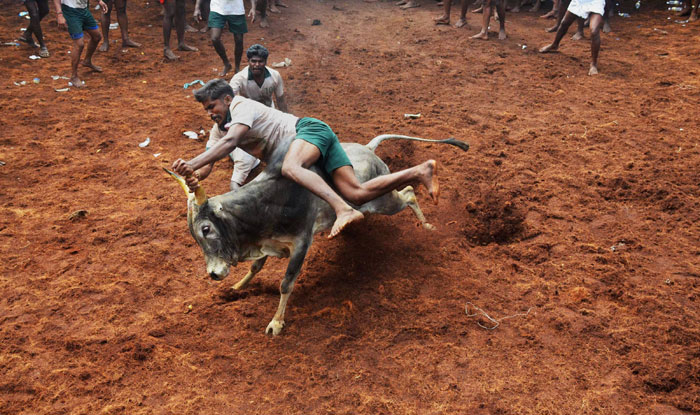The Jallikattu may be 5,000 years old, but whether the controversial bull fighting sport can continue will be decided legally, the Supreme Court (of India) told Tamil Nadu (state government) in sharp remarks today (July 26).
Rubbishing the state’s plea that Jallikattu should be allowed because it is a centuries old tradition, the court said, “In 1899, tens of thousands of girls below 12 years of age were married. Should we allow it today because it was a tradition at that time?”
The court said that it was a “constitutional and statutory issue” and that it would examine whether such a sport was permissible in law or not.

From Indian Express
The Animal Welfare Board of India (AWBI) and People for the Ethical Treatment of Animals (PETA), through various reports, affidavits and photographs, has argued that Jallikattu bulls are physically and mentally tortured for the pleasure and enjoyment of human beings. They have also produced visual evidence for torture and cruelty to bullocks in Maharashtra’s bullock-cart races. According to AWBI, Jallikattu or bullock-cart races conducted in this way have no historical, cultural or religious significance in Tamil Nadu or Maharashtra, and that the Prevention of Cruelty to Animals (PCA) Act, 1960, must supersede any such practice.
Jallikattu exploits bulls’ natural nervousness as prey animals by deliberately placing them in a terrifying situation in which they are forced to run away from those they perceive as predators. As PETA India has documented in Animal Welfare Board of India (AWBI)–authorised inspections, the bulls become so frightened by the mob of men who participate that they slip, fall, run into barriers and traffic – and even jump off cliffs in their desperate attempts to escape – frequently leading to broken bones or death.
As can be seen in the documentation, jallikattu participants purposely disorient the bulls by forcing them to consume alcohol; twist and bite their tails; stab and jab them with sickles, spears, knives and sticks; cause them intense pain by yanking their nose ropes; and punch them, jump on them and drag them to the ground.
PETA India has also documented that during races, bulls run because people hurt them. They’re hit with everything from bare hands to nail-studded sticks, and their tailbones are broken at each joint. This is as painful to the bulls as it would be to us if someone were to break our fingers joint by joint.
In bullfights, the round ends when one of the frightened and injured bulls manages to flee – or is killed.
There is tremendous political pressure to exempt Jallikattu from the Prevention of Cruelty against Animals act 1960. Both the central and state Governments are using all their might.
Though the final verdict has not come out yet it’s good to see the Supreme Court has its priorities right. How ever old or “traditional” is a custom, it should be judged using current ethical standards. There in no room for such cruel “sport” in a civilised world.


FUCK tradition! “We’ve always done it that way” is NOT a good enough reason to keep doing it that way!
Psychopathy – because its’ a tradition.
So much for the stereotype of Indians worshipping – or even paying minimal consideration to – cattle.
Pain an suffering are useless beyond their ability to signal that something is wrong. To needlessly inflict suffering upon a sentient being is reprehensible and constitutes evidence of socio-pathology.
That said, I wouldn’t anyone to get too high and mighty pointing at other cultures.
Operating from memory here, but , as I understand it, in western Europe during the 1500s it was thought that physical distress and pain inflicted upon a food animal made the meat taste better. For royal banquets a bull was slowly flogged to death by teams of men taking turns using whips. This was considered the height of culinary sophistication and an expensive process undertaken to demonstrate wealth and the extreme measures they were willing go through to provide only the finest delicacies for their guests.
This seems to be a cross-cultural meme. The idea that suffering imparts some refinement or goodness. It seems to be tied to the idea of a balanced world where every unit of suffering is balanced by a similar weight of delight.
I have friends that have a visceral misunderstanding of probability where long stretches of failure imply greater odds of success. He has played the lottery every day for two months so he is ‘overdue’ for a win. When I pointed out that probability doesn’t work that way he doesn’t understand and goes on and buys more lottery tickets.
It seems to be a common human thought defect.
As I understand it the torture of this poor animal, its misfortune, may be seen as absorbing and depleting the ambient misfortune in the locality to provide a richer atmosphere of luck to people present.
Given the average level of luck of the participants, measured by evidence of prosperity, the magic doesn’t seem to be working. I would suggest that they leave to poor animal alone and invest their time and efforts into infrastructure and education. They, most likely, would suggest that I mind my own business, and that the magic isn’t working because they aren’t torturing nearly enough animals deeply enough to get the desired effect. I suggest that they change tactics and they, of course, double-down.
I feel sorry for the animal being tortured, the men doing it, the society that tolerates this sort of things, and the human race being burdened by brains that are inherently flawed and tragically dysfunctional.
So it goes.
?